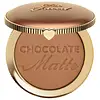bareMinerals Limited Edition Eco-Beautiful All Over Face Color Warmth Loose Bronzer Versus Too Faced Chocolate Soleil Matte Bronzer
What's inside
What's inside
 Key Ingredients
Key Ingredients

No key ingredients
 Benefits
Benefits

No benefits
 Concerns
Concerns

 Ingredients Side-by-side
Ingredients Side-by-side

Talc
AbrasiveMica
Cosmetic ColorantTitanium Dioxide
Cosmetic ColorantOctyldodecyl Stearoyl Stearate
EmollientEthylhexyl Palmitate
EmollientBoron Nitride
AbsorbentZinc Stearate
Cosmetic ColorantSodium Saccharin
MaskingParfum
MaskingSilica
AbrasiveSodium Dehydroacetate
PreservativePhenoxyethanol
PreservativeBenzyl Benzoate
AntimicrobialTocopherol
AntioxidantAscorbyl Palmitate
AntioxidantTheobroma Cacao Fruit Powder
Skin ConditioningBenzyl Alcohol
PerfumingCI 77491
Cosmetic ColorantCI 77492
Cosmetic ColorantCI 77499
Cosmetic ColorantCI 77742
Cosmetic ColorantTalc, Mica, Titanium Dioxide, Octyldodecyl Stearoyl Stearate, Ethylhexyl Palmitate, Boron Nitride, Zinc Stearate, Sodium Saccharin, Parfum, Silica, Sodium Dehydroacetate, Phenoxyethanol, Benzyl Benzoate, Tocopherol, Ascorbyl Palmitate, Theobroma Cacao Fruit Powder, Benzyl Alcohol, CI 77491, CI 77492, CI 77499, CI 77742
Ingredients Explained
These ingredients are found in both products.
Ingredients higher up in an ingredient list are typically present in a larger amount.
This ingredient is used to add a violet color to cosmetics.
It is created by reacting phosphoric acid, ammonium dihydrogen orthophosphate, and manganese dioxide.
Mica is a naturally occurring mineral used to add shimmer and color in cosmetics. It can also help improve the texture of a product or give it an opaque, white/silver color.
Serecite is the name for very fine but ragged grains of mica.
This ingredient is often coated with metal oxides like titanium dioxide. Trace amounts of heavy metals may be found in mica, but these metals are not harmful in our personal products.
Mica has been used since prehistoric times throughout the world. Ancient Egyptian, Indian, Greek, Roman, Aztec, and Chinese civilizations have used mica.
Learn more about Mica